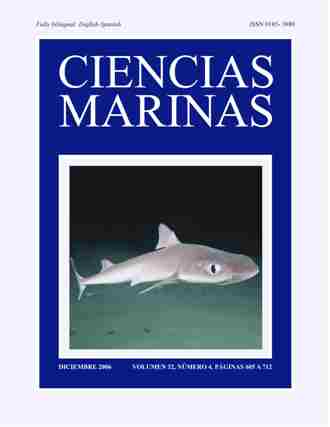Mean temperature and salinity along an isopycnal surface in the upper ocean off Baja California
Contenido principal del artículo
Resumen
Se estudiaron los campos medios de las propiedades termodinámicas de la superficie de 25? en la parte sur de la Corriente de California utilizando datos del programa Investigaciones Mexicanas de la Corriente de California (IMECOCAL) de 1998 a 2005. Se implementó el método de análisis objetivo para los datos de CTD. El método fue validado por medio de ensayos Monte Carlo. Las escalas de correlación óptimas fueron LY = 110 km y LX = 90 km, en dirección paralela y perpendicular a la costa, respectivamente. En concordancia con el balance geostrófico, la superficie media de 25? estuvo inclinada, con la parte más somera (38 m) cerca de la costa y la parte más profunda (68 m) mar adentro. El área más lejana de la costa se encontró dominada por remolinos. Al norte de Punta Eugenia resaltaron amplias áreas de baja temperatura (<14.0ºC) y salinidad (<33.6), mientras que al sur dominaron altas temperaturas (>14.4ºC) y salinidades (>33.7). De esta manera Punta Eugenia, en promedio, resulta la zona donde confluyen las aguas cálidas y saladas de origen ecuatorial y las aguas frías y poco saladas de origen subártico. La variabilidad de los campos termodinámicos indica que hay tres zonas distintas: la norte (29–31ºN), de variabilidad preponderantemente baja, la sur (25–27.5ºN), de variabilidad preponderantemente alta, y la central, de variabilidad media entre las otras dos. La discriminación entre estas tres zonas fue corroborada mediante análisis de gradientes de temperatura y de salinidad, y mediante perfiles verticales medios de las tres zonas.
The mean thermodynamic fields along the 25? surface in the southern region of the California Current were studied using the 1998–2005 data from the IMECOCAL (Mexican Research of the California Current) program. The method of objective analysis was implemented and subsequently validated by Monte Carlo tests. The optimum correlation scales, in parallel and perpendicular direction to the coast, were LY = 110 km and LX = 90 km, respectively. In agreement with geostrophic balance, the mean 25? surface was inclined, with the shallower part (38 m) near the shore and the deeper part (68 m) offshore. The area farthest from the coast was dominated by eddies. Extensive areas of low temperature (<14.0ºC) and salinity (<33.6) were found to the north of Point Eugenia, while higher temperatures (>14.4ºC) and salinities (>33.7) occurred to the south. Point Eugenia, therefore, is generally the converging zone where warm, salty equatorial water meets the cold, less salty subarctic water. The variability of the thermodynamic fields revealed the presence of three different zones: the northern (29–31ºN) low variability zone, the southern (25–27.5ºN) high variability zone, and the central zone of moderate variability. The distinction of these three zones was corroborated by analysis of temperature and salinity gradients, as well as by in situ vertical profiles.
The mean thermodynamic fields along the 25? surface in the southern region of the California Current were studied using the 1998–2005 data from the IMECOCAL (Mexican Research of the California Current) program. The method of objective analysis was implemented and subsequently validated by Monte Carlo tests. The optimum correlation scales, in parallel and perpendicular direction to the coast, were LY = 110 km and LX = 90 km, respectively. In agreement with geostrophic balance, the mean 25? surface was inclined, with the shallower part (38 m) near the shore and the deeper part (68 m) offshore. The area farthest from the coast was dominated by eddies. Extensive areas of low temperature (<14.0ºC) and salinity (<33.6) were found to the north of Point Eugenia, while higher temperatures (>14.4ºC) and salinities (>33.7) occurred to the south. Point Eugenia, therefore, is generally the converging zone where warm, salty equatorial water meets the cold, less salty subarctic water. The variability of the thermodynamic fields revealed the presence of three different zones: the northern (29–31ºN) low variability zone, the southern (25–27.5ºN) high variability zone, and the central zone of moderate variability. The distinction of these three zones was corroborated by analysis of temperature and salinity gradients, as well as by in situ vertical profiles.
Descargas
Los datos de descargas todavía no están disponibles.
Detalles del artículo
Cómo citar
Jerónimo, J., & Gómez-Valdés, J. (2006). Mean temperature and salinity along an isopycnal surface in the upper ocean off Baja California. Ciencias Marinas, 32(4), 663–671. https://doi.org/10.7773/cm.v32i4.1164
Número
Sección
Artículo de investigación
Este es un artículo de acceso abierto distribuido bajo una licencia Creative Commons Attribution 4.0, que le permite compartir y adaptar el trabajo, siempre que dé el crédito apropiado al autor o autores originales y la fuente, proporcione un enlace a Creative Commons licencia, e indicar si se realizaron cambios. Las figuras, tablas y otros elementos del artículo están incluidos en la licencia CC BY 4.0 del artículo, a menos que se indique lo contrario. El título de la revista está protegido por derechos de autor y no está sujeto a esta licencia. La escritura de licencia completa se puede ver aquí.

